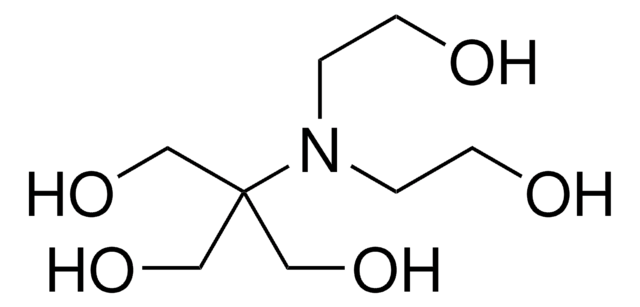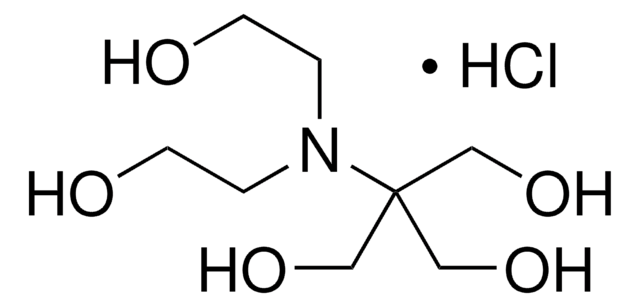Kluczowe dokumenty
B9754
BIS-TRIS
≥98.0% (titration)
Synonim(y):
2,2-Bis(hydroxymethyl)-2,2′,2″-nitrilotriethanol, 2-Bis(2-hydroxyethyl)amino-2-(hydroxymethyl)-1,3-propanediol, Bis(2-hydroxyethyl)amino-tris(hydroxymethyl)methane
About This Item
Polecane produkty
Próba
≥98.0% (titration)
Formularz
crystalline powder
warunki przechowywania
dry at room temperature
metody
UV/Vis spectroscopy: suitable
electrophoresis: suitable
kolor
white
przydatny zakres pH
5.8-7.2
pKa (25°C)
6.5
rozpuszczalność
H2O: 500 mg/mL, clear, colorless to very faintly yellow
przydatność
suitable for Western blot
suitable for column chromatography of proteins
Zastosowanie
diagnostic assay manufacturing
general analytical
microbiology
ciąg SMILES
OCCN(CCO)C(CO)(CO)CO
InChI
1S/C8H19NO5/c10-3-1-9(2-4-11)8(5-12,6-13)7-14/h10-14H,1-7H2
Klucz InChI
OWMVSZAMULFTJU-UHFFFAOYSA-N
Szukasz podobnych produktów? Odwiedź Przewodnik dotyczący porównywania produktów
Powiązane kategorie
Opis ogólny
Zastosowanie
- as a buffer for Electrophoresis
- as a component of transfer buffer for Western Blotting
Cechy i korzyści
- Suitable for Biological and Biochemical Research
- Effective Buffering from pH 5.8-7.2 (25 °C) with a pKa of 6.5 (25 °C)
Inne uwagi
Hasło ostrzegawcze
Warning
Zwroty wskazujące rodzaj zagrożenia
Zwroty wskazujące środki ostrożności
Klasyfikacja zagrożeń
Eye Irrit. 2
Kod klasy składowania
11 - Combustible Solids
Klasa zagrożenia wodnego (WGK)
WGK 1
Temperatura zapłonu (°F)
Not applicable
Temperatura zapłonu (°C)
Not applicable
Środki ochrony indywidualnej
dust mask type N95 (US), Eyeshields, Gloves
Wybierz jedną z najnowszych wersji:
Masz już ten produkt?
Dokumenty związane z niedawno zakupionymi produktami zostały zamieszczone w Bibliotece dokumentów.
Klienci oglądali również te produkty
Protokoły
Enzymatic Activity of Glucose-6-Phosphatase [EC 3.1.3.9]
Nasz zespół naukowców ma doświadczenie we wszystkich obszarach badań, w tym w naukach przyrodniczych, materiałoznawstwie, syntezie chemicznej, chromatografii, analityce i wielu innych dziedzinach.
Skontaktuj się z zespołem ds. pomocy technicznej












